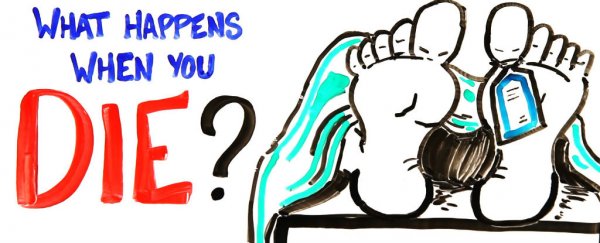Death is everywhere. Every single minute, an average of 100 people die somewhere in the world, and we humans aren't great at coming to terms with that, or the inevitability of our own demise. But understanding how our bodies end up when they finally give out is a crucial part of knowing how they function in life, so AsapSCIENCE is here to take us through a blow-by-blow account of death, according to science.
Within seconds of death, your body's supply of oxygen will be depleted, and your brain activity surges. This might sound a little counter-intuitive, seeing as dead people don't have thoughts, but you can think of this activity as the last dying bursts of activity from neurons that are no longer supported by oxygen and hormone production.
The body's stores of adenosine triphosphate (ATP) - the body's main source of energy - are also depleted, so following any last-second twitches, your muscles will totally relax, including sphincter. This means if your bowels were full at the time of death, they won't be for very long. (We told you this would be morbid.)
In light-skinned people, your body won't start taking on that stale deathly hue until about 15 to 20 minutes after death, at which point the lack of blood flow to the capillaries starts to drain the colour out of you.
And if that sounds gross, think about this - because your heart has stopped pumping, there's nothing pushing your blood around your body, so depending on how your body is positioned when you die, the blood will end up pooling around down the bottom.
As the video above explains, the longer this 'blood pooling' is left to sit, the more your skin will take on a reddish-purple discolouration, which will hit its maximum intensity at around the 12-hour mark.
It's not the nicest thing in the world to think about, but the way our blood pools and discolours our skin can tell coroners a whole lot about when we died, and how we were positioned at the time of death.
At around 3 to 6 hours after death, your body will experience the infamous process of rigor mortis. This occurs because when your cell organelles start deteriorating, they release calcium into muscle cells, and these bind to proteins that are responsible for muscle contraction. This means that your body will completely stiffen up, and you could be stuck in a really strange position for as long as 24 to 48 hours after death.
By this point, hopefully someone has found you, because decay is well and truly on its way. I'll let the boys from AsapSCIENCE explain all the gory details of that process in the video above, but let's just say you're going to get up close and personal with a little thing called putrefaction, and it's about as pleasant as it sounds. Enjoy…
And now that you know the science behind what happens to the corpse, check out the video below of the world's largest body farm, which is giving scientists the opportunity to learn even more about what death does to our bodies, thanks to a number of donated corpses. Warning: this is not easy watching, please mentally prepare yourself before clicking play!
